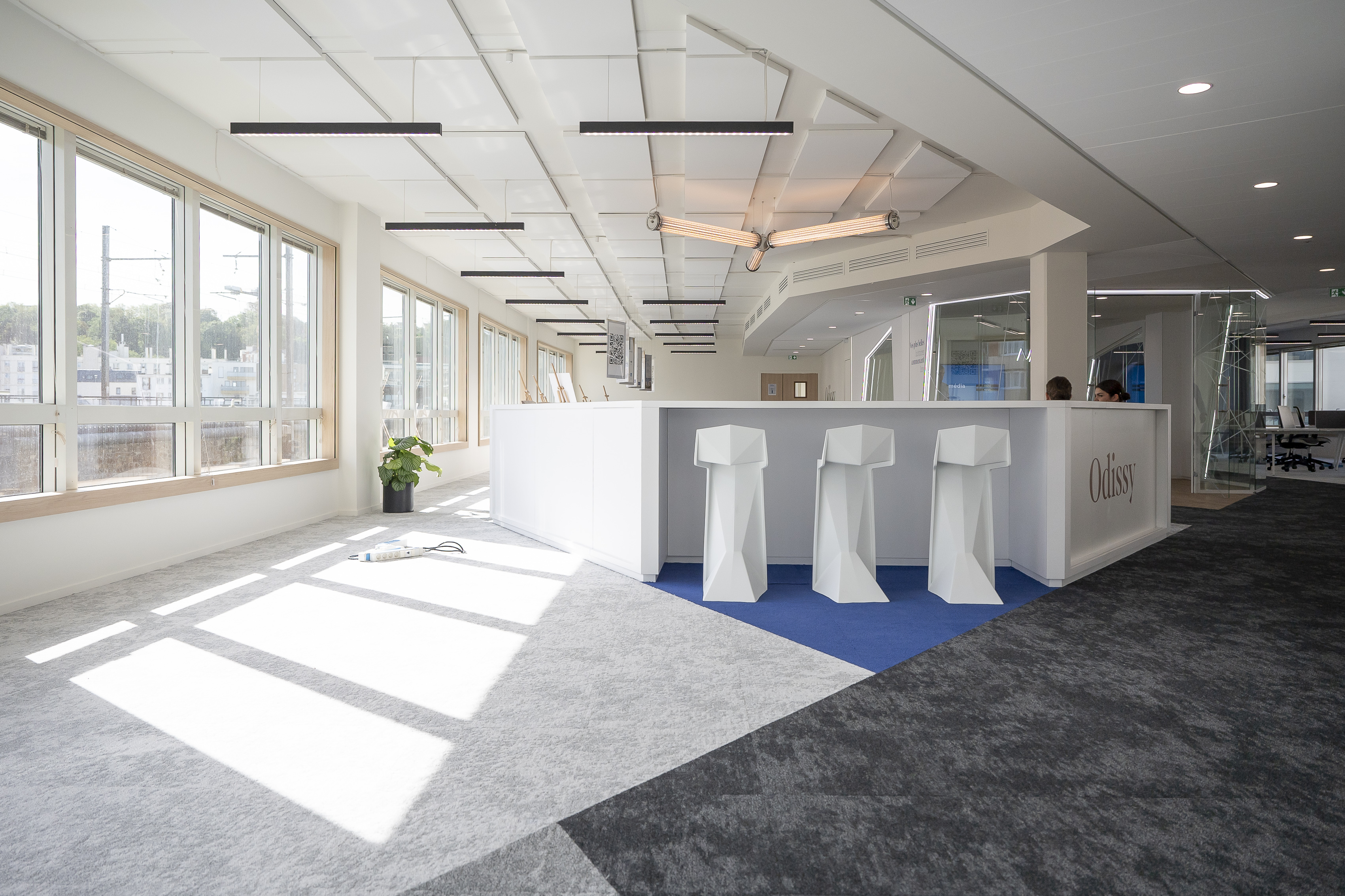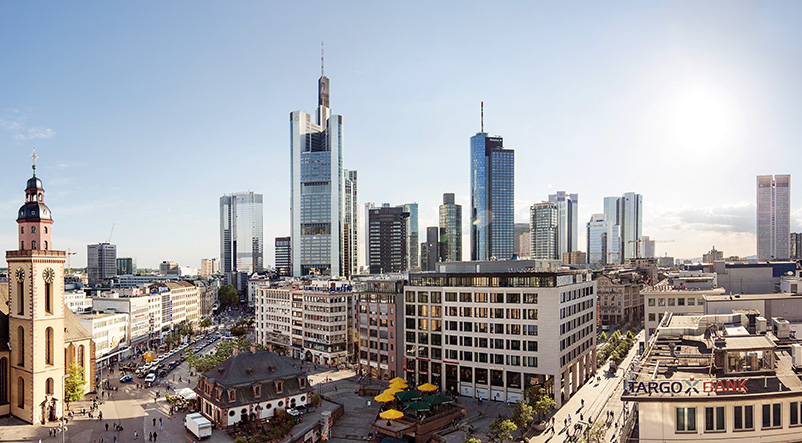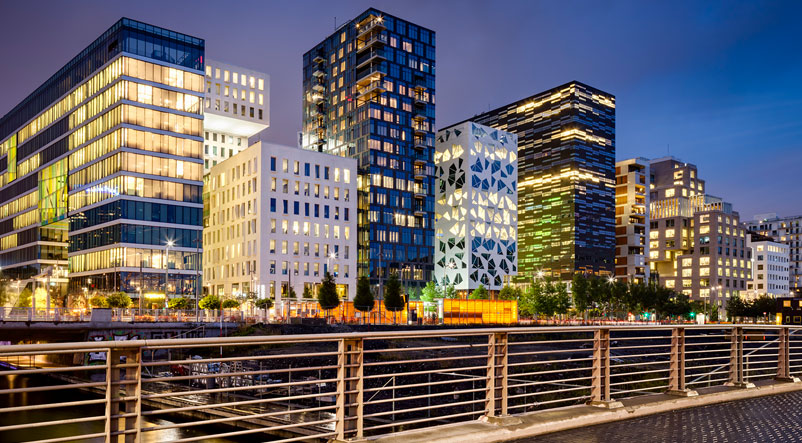
Don’t settle for excellent: how Fidelity International created one of France's greenest buildings
A newly refurbished office block in southwest Paris has been awarded BREEAM Outstanding accreditation for its refurbishment and fit-out – one of only three buildings in the country to do so. This is a renovation that has transformed the building’s interiors, its energy use, running costs, and the investment returns.
Originally published on September 25, 2024, by Fidelity International.
Written by Meriem Dadi, Senior Asset Manager, Real Estate, and Nina Flitman, Senior Writer.
If the Paris 2024 Olympic and Paralympic Games this summer taught us anything, it’s that sometimes excellence is not enough. You need to be at the very pinnacle of your discipline to even have a chance of reaching a medal position; you need to be outstanding.
Elsewhere in the city, another contender has reached the podium by doing just that. The Odissy office building just southwest of Paris has become only the second building in the city to achieve the Outstanding rating from BREEAM RFO,[1] making it one of the top three sustainably renovated buildings in France.
It wasn’t always to be. At the design stage of Fidelity’s planned retrofit, the project was forecast to achieve an Excellent rating only. This would still have marked a dramatic upgrade to the 6,500 sqm office space, which was undergoing its first renovation in more than 15 years. But our discussions with tenants in other buildings and with real estate brokers unveiled a big appetite from companies looking to let the most sustainable offices possible. Not only did they want to meet their own sustainability goals and to comply with regulation, but they also wanted to optimize the operational costs of their real estate footprint, especially given the rising price of power.
Calculations suggested we could push our efforts to attain the top Outstanding rating for sustainability, overshooting regulatory targets by at least 85%. It was an obvious choice to raise the asset to the highest standard of current market demand.
The 15-million-euro refurbishment plan has completely decarbonized the building, cutting its reliance on carbon-based fuels to zero, while also reducing its operating energy by more than 60%.
All in the detail
On a practical level, this entailed a complete regeneration of the building from basement to roof garden, with all of its systems upgraded to ensure that energy would be used in the most efficient way.
Looking at the reduction in the primary energy demand:
- Thirty-four percent came from switching out the lighting system to a more efficient LED network controlled by a building management system (BMS) which adapts lighting depending on occupancy.
- Sixty-two percent came from upgrading the heating, cooling, and ventilation systems, again linking them to the BMS. A new heat pump yields 5 kW of heating from 1 kW of electricity, compared to 1 kW from 1 kW of the previous model.
- The remaining 4% came from using best-in-class equipment for everything from the lifts to how hot water is provided.
Even water is being used as effectively as possible. New hydro-efficient appliances are now in place, while a watering system in the garden uses a drop-by-drop process based on plants’ needs rather than irrigating entire flower beds.

Embodying sustainability
The renovation process itself had green credentials at its core. The volume of embodied carbon – the emissions generated by the production, transportation, and installation of materials – from a building project can be monumental: almost one-third of the real estate industry’s carbon emissions are from this source.[2]
On this project we were able to cut the embodied carbon emissions by 55%, compared to a typical office refurbishment in Western Europe.[3] Where possible, materials were reused on the site – all of the building’s false floors, for example, were relaid in the building – while 90% of what had to be removed was recycled rather than being sent to landfill. Our design was simplified as much as possible to use the smallest volume of new materials. Where things had to be procured, we focused on local and recycled products.
Let there be light
The space had previously been on a long-term let and hadn’t had a refurbishment for more than a decade. When we first took the keys, its partitioned layout felt old-fashioned and dark. By making the floors open-plan, the new design feels airier. Common areas for workers have been created both inside and out, with green spaces, roof terraces and even an open-air meeting room.
These adaptations make the building more attractive to tenants, but it also served an important function for attaining the BREEAM accreditation, which considers both the sustainability of an asset and the health and well-being of those that use it. Often, these two ambitions can be achieved with one element. For example, the upgraded ventilation system not only uses less energy but also enhances air quality, while better insulating materials in the open spaces mean there is less heat lost and less noise generated. Similarly, the building’s new innovative design encourages employees to use the stairs rather than the lifts, not only boosting their step-counts but also cutting the amount of power used.
But this isn’t the only legwork we’re expecting from the building’s tenants. We encourage them to use a power supplier with a smaller carbon footprint too, whether that’s through renewable energy that’s generated on-site or buying green energy from external sources.
The building already has smart metering installed so that we can collect, monitor, and analyze data about how energy is being used. Frequent meetings with the tenants will allow us to discuss our findings and support best practices.
A podium finish
Not only is Odissy built for sustainability, it has already reached its 2050 targets for energy efficiency and reached its 2042 targets for carbon emissions – a pathway that could still be accelerated once a tenant commits to decarbonized energy.
The renovations help the building meet its financial objectives too. Lower operational costs should mean that office blocks like this can attract higher prices from tenants or buyers, while also being let or sold more quickly when out to market. Thanks to the equipment and reduced energy consumption, the building is expected to cost two-thirds less per square metre compared to a typical office building. This saving will be shared between both the tenant (through reduced operating costs) and investors. An asset that has undergone this sort of renovation could expect to deliver a green premium of around 7%, and in total this kind of refurbishment may increase the value of a building by around 40%.[4]
By creating value through decarbonization, clever design, and green components, the renovation of the Odissy has transformed this space from a drab old office block to one of the most notable buildings in the country. A truly Olympian feat.
1 Building Research Establishment Environmental Assessment Methodology For Refurbishment and Fit-Out.
2 Demystifying Net Zero Buildings, JLL.
3 “Embodied Carbon for Western European Office Building,” OneClick LCA.
4 Buildings that go green: Making an impact while still making alpha, Fidelity International 2024.
Issued by Fidelity Investments Canada ULC (“FIC”). Unless otherwise stated, all views expressed are those of Fidelity International, which acts as a subadvisor in respect of certain FIC institutional investment products or mandates.
For institutional use only.
This document is for investment professionals only and should not be relied on by private investors.
This document is provided for information purposes only and is intended only for the person or entity to which it is sent. It must not be reproduced or circulated to any other party without the prior permission of Fidelity.
This document does not constitute a distribution, an offer or solicitation to engage the investment management services of Fidelity, or an offer to buy or sell or the solicitation of any offer to buy or sell any securities in any jurisdiction or country where such distribution or offer is not authorized or would be contrary to local laws or regulations. Fidelity makes no representations that the contents are appropriate for use in all locations or that the transactions or services discussed are available or appropriate for sale or use in all jurisdictions or countries or by all investors or counterparties.
This communication is not directed at and must not be acted on by persons inside the U.S. and is otherwise only directed at persons residing in jurisdictions where the relevant funds are authorized for distribution or where no such authorization is required. Fidelity is not authorized to manage or distribute investment funds or products in, or to provide investment management or advisory services to persons resident in, mainland China. All persons and entities accessing the information do so on their own initiative and are responsible for compliance with applicable local laws and regulations and should consult their professional advisors.
Reference in this document to specific securities should not be interpreted as a recommendation to buy or sell these securities but is included for the purposes of illustration only. Investors should also note that the views expressed may no longer be current and may have already been acted upon by Fidelity. The research and analysis used in this documentation is gathered by Fidelity for its use as an investment manager and may have already been acted upon for its own purposes. This material was created by Fidelity International.
This article has been provided by Fidelity Investments Canada ULC (Fidelity) and is for informational purposes only. It comprises, among other things, examples of sustainable investing activities across Fidelity and FIL Limited (Fidelity International) only, current as of September 25, 2024. The article may refer to ESG considerations that Fidelity and Fidelity International may take into account as part of their research or investment process, and is not necessarily reflective of the approach of any other Fidelity Investments company or sub-advisor, such as Fidelity Management & Research Company LLC, FIAM LLC, Geode Capital Management, LLC, and State Street Global Advisors Ltd., to ESG research, stewardship and sustainable investing, either specifically or generally.
Past performance is not a reliable indicator of future results.
This document may contain materials from third parties which are supplied by companies that are not affiliated with any Fidelity entity (third-party content). Fidelity has not been involved in the preparation, adoption or editing of such third-party materials and does not explicitly or implicitly endorse or approve such content.
Fidelity International refers to the group of companies which form the global investment management organization that provides products and services in designated jurisdictions outside of North America. Fidelity, Fidelity International, the Fidelity International logo and F symbol are trademarks of FIL Limited. Fidelity only offers information on products and services and does not provide investment advice based on individual circumstances.
©2024 Fidelity Investments Canada ULC. All rights reserved.



